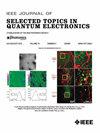Spatio-Temporal Simulation of Laser Speckles Using Stochastic Differential Equations
IF 5.1
2区 工程技术
Q1 ENGINEERING, ELECTRICAL & ELECTRONIC
IEEE Journal of Selected Topics in Quantum Electronics
Pub Date : 2025-03-19
DOI:10.1109/JSTQE.2025.3571385
引用次数: 0
Abstract
Laser speckle imaging modalities are receiving considerable attention for applications in both superficial and deep tissue imaging. This growing interest arises from their straightforward and cost-effective instrumentation, as well as the ease of computational implementation. Recent developments in this field require the calibration of devices, which often necessitates the simulation of dynamic laser speckles in tissue. Previous simulation models have predominantly relied on statistical tools such as copulas or Fourier transform methods based on diffraction theory. In our recent work, we introduced the use of Stochastic Differential Equations (SDEs) to model the temporal evolution of speckles, utilizing a predetermined probability density function and temporal autocorrelation. We further extended this simulation to create a calibrating phantom by inputting the stochastic time series data generated by SDEs into a piezo actuator. In the previous studies, the time evolution of each pixel was modeled independently using multiple SDEs. In the current work, we introduce a method for generating spatio-temporal dynamics of speckles characterized by predefined spatial and temporal correlation structures. This approach integrates SDE with Cholesky decomposition and inverse sampling method to achieve the desired spatial correlation profiles. The simulation results are obtained for practically feasible experimental parameters, effectively generating speckles that closely approximate the values observed in experimental settings.基于随机微分方程的激光散斑时空模拟
激光散斑成像模式在浅表和深层组织成像中的应用受到了相当大的关注。这种日益增长的兴趣源于它们的直接和经济有效的仪器,以及易于计算实现。该领域的最新发展需要对设备进行校准,这通常需要模拟组织中的动态激光斑点。以前的模拟模型主要依赖于统计工具,如copula或基于衍射理论的傅立叶变换方法。在我们最近的工作中,我们介绍了使用随机微分方程(SDEs)来模拟斑点的时间演变,利用预定的概率密度函数和时间自相关。通过将SDEs生成的随机时间序列数据输入到压电致动器中,我们进一步扩展了该模拟以创建校准幻像。在以往的研究中,每个像素点的时间演化都是使用多个SDEs独立建模的。在当前的工作中,我们介绍了一种生成以预定义的时空相关结构为特征的散斑的时空动态的方法。该方法将SDE与Cholesky分解和逆采样方法相结合,以获得所需的空间相关曲线。在实际可行的实验参数下,得到了仿真结果,有效地生成了与实验值接近的散斑。
本文章由计算机程序翻译,如有差异,请以英文原文为准。
求助全文
约1分钟内获得全文
求助全文
来源期刊

IEEE Journal of Selected Topics in Quantum Electronics
工程技术-工程:电子与电气
CiteScore
10.60
自引率
2.00%
发文量
212
审稿时长
3 months
期刊介绍:
Papers published in the IEEE Journal of Selected Topics in Quantum Electronics fall within the broad field of science and technology of quantum electronics of a device, subsystem, or system-oriented nature. Each issue is devoted to a specific topic within this broad spectrum. Announcements of the topical areas planned for future issues, along with deadlines for receipt of manuscripts, are published in this Journal and in the IEEE Journal of Quantum Electronics. Generally, the scope of manuscripts appropriate to this Journal is the same as that for the IEEE Journal of Quantum Electronics. Manuscripts are published that report original theoretical and/or experimental research results that advance the scientific and technological base of quantum electronics devices, systems, or applications. The Journal is dedicated toward publishing research results that advance the state of the art or add to the understanding of the generation, amplification, modulation, detection, waveguiding, or propagation characteristics of coherent electromagnetic radiation having sub-millimeter and shorter wavelengths. In order to be suitable for publication in this Journal, the content of manuscripts concerned with subject-related research must have a potential impact on advancing the technological base of quantum electronic devices, systems, and/or applications. Potential authors of subject-related research have the responsibility of pointing out this potential impact. System-oriented manuscripts must be concerned with systems that perform a function previously unavailable or that outperform previously established systems that did not use quantum electronic components or concepts. Tutorial and review papers are by invitation only.
 求助内容:
求助内容: 应助结果提醒方式:
应助结果提醒方式:


